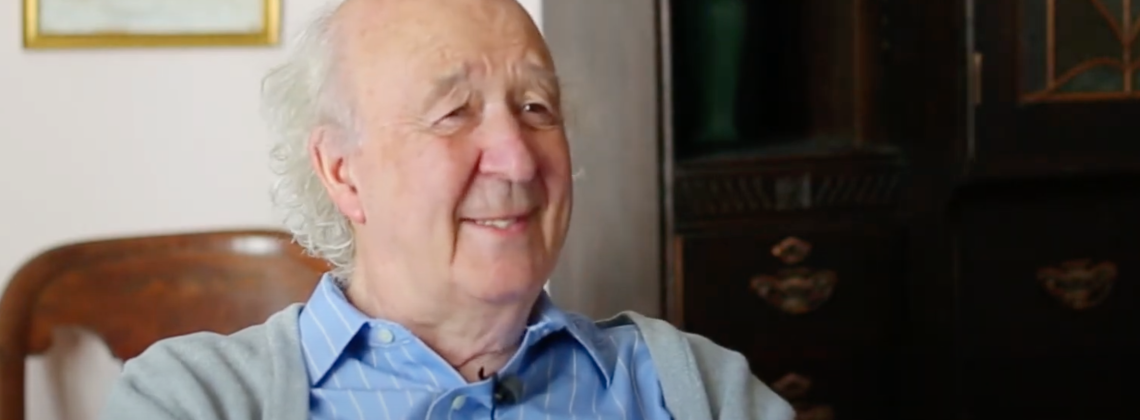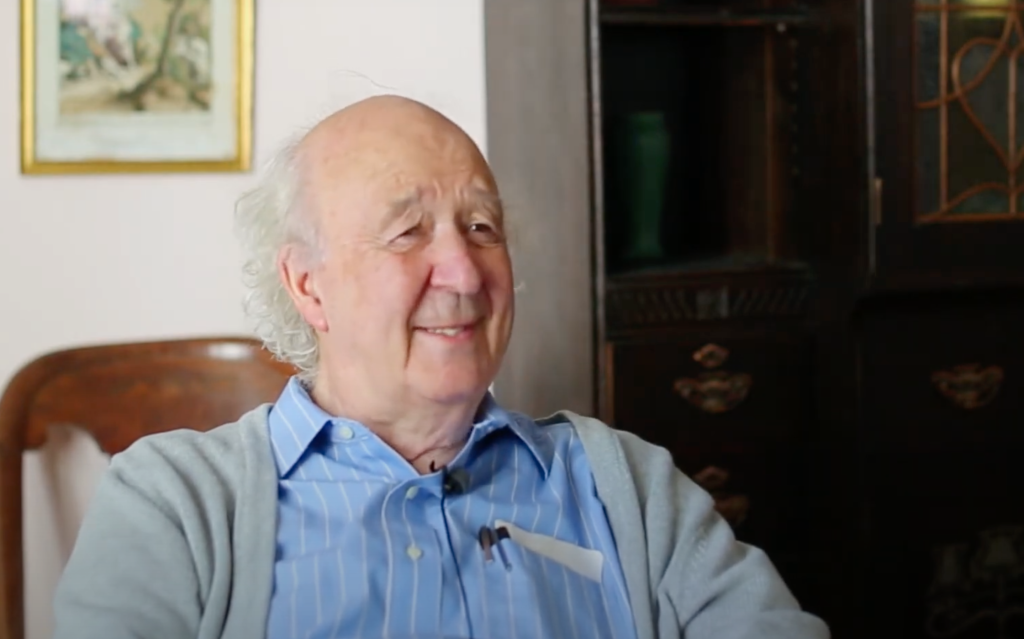

In Peter Brown’s journey, wonder and disquiet led the way to late antiquity
Journeys of the Mind: A Life in History by Peter Brown. Princeton University Press, 2023. 736 pp. $45.00
Peter Brown is best known as a scholar whose creativity revolutionized the study of history by fashioning an entirely new field out of what had once been disparaged as “the fall of Rome.” Brown dared to peer with new eyes into the “Dark Ages” of the third through ninth centuries and revealed a diversity of dazzling societies. Their transformation of the classical world produced new polities, art, and religious cultures in the era Brown synthesized as “late antiquity.”
For Brown, late antiquity is a paradoxical product of tradition and change:
Here was a civilization that had maintained, to a far greater degree than previous scholars had expected, innumerable links with the classical world that had preceded it. Yet, at the same time, it had opened itself up to face new dangers and new experiences. It eventually witnessed the transfer of much of its cultural and religious riches into new worlds—into the Christian church, into Judaism, ultimately into the world of medieval Islam and its neighbors, Byzantium and the Catholic medieval West. . . . How were we to do justice to the tension between past and present, continuity and discontinuity, inherent in the notion of the transformation of the classical heritage?
For nearly three quarters of a century, Brown has investigated this transformation. This present book, however, traces a different transformation—that of Brown himself. Not only does Brown describe how the intellectual journeys of a boy from interwar Dublin eventually transported his readers to worlds more than a millennium away, he also offers a fascinating survey of the changes in the writing of history. While modesty leads Brown to portray himself as merely journeying to the right place at the right time, the insightful reader will see that it was often Brown’s own humility and open-mindedness as a scholar that allowed him to plot out new intellectual itineraries. Those journeys have transformed our understandings of the histories of the Roman Empire, early Christianity, Islam, the Byzantine East, and the European West.
The book follows Brown on four literal and figurative journeys. The first traces Brown’s family history as middle-class Protestants in Ireland and ends with Brown studying in England. For readers familiar with Brown as historian of late antiquity, these events find striking echoes in Brown’s historical imagination: Catholic clergy were ever-present but ominous to the Protestant boy. Brown’s father worked in British Sudan, where Brown also traveled. He thus came into firsthand contact (through his nanny Martha) with the ancient Christianities of Ethiopia and Egypt. In England, Brown’s academic skill permitted membership in an elite world where he would nevertheless remain an outsider.
Brown finds in these events the beginnings of topics that have captivated him as a scholar: the power of elites, the solidity and permeability of ethnic and linguistic identities, the nature of paideia and religious authority, the proximity and distance of Eastern Christianities to those of Europe. Brown’s genius is his determination to never be hedged in by established historical interpretations.
For example, as an Oxford undergraduate Brown found a fellow traveler in C.S. Lewis. Both were medievalists amongst modernists, outsiders never truly at home in English society: “What I truly admired in Lewis was his ability to treat his readers with respect. He wrote for the average Christian. He deplored the tendency to assume that laypersons were uninterested in theology. . . . But there was more to it than that. I was also touched by Lewis’s robust notion of the innate desire for God.” Like Lewis, Brown sought to write for the average educated reader. In Brown’s case, his Dublin aunts make recurring cameo appearances as the intended audience of his books.
In time, Brown’s empathy for outsiders grew even wider. A second journey in the book is Brown’s desire to escape the self-satisfied intellectual confines of Oxford and connect to scholarly cultures beyond the British Isles. Brown traveled, intellectually, to the world of continental scholarship, most prominently through the influence of Arnaldo Momigliano but also through Henri Marrou, Dimitri Obolensky, and others. (The book is full of wonderful anecdotes, such as Brown hiding in the Lower Bodleian to avoid giving Momigliano a lack-of-progress report.) One is struck by the number of scholars whose post-war perspectives as emigrés Brown acknowledges for opening new worlds to him.
Brown’s third journey is more literal. His historical insights are inspired by encountering cultures situated in landscapes. A visit to Cairo prompts an interest in the gap between wealth and poverty. Travel to Iran and Afghanistan propels his interest in Islam. A diverse array of visits to both ancient and contemporary religious sites includes a Billy Graham crusade in London, the Romanesque shrines of Burgundy, the Imam Reza shrine in Meshad, an Armenian liturgy in Julfa, and the majestic forests and beaches of Marin County, California (complete with medieval reenactors!).
In a typically understated comment, Brown reveals how in situ investigation of people defied his earlier functionalist explanations of religious behavior, both academically and personally. He notes that experiences in Iran even moved him, in the late 1970s, to resume regular attendance at a Christian church after a “lapse of twenty years.” What unites these experiences is Brown’s willingness to let himself—and his readers—be surprised by the past: “I attempted to give readers a tingle of vertigo, as they looked down a drop of almost two millennia into a world that shared little or nothing of our own, modern notions of art and religion. I also wanted to take objects, such as icons, Gospel books, or precious relic cases, out of the hygienic exhibition cases of museums and place them back into the noise and movement of their original context.”
A fourth journey is Brown’s own migrations across disciplines and across educational systems. A common thread to Brown’s career is his determination to open new areas of historical investigation by looking into presumed dead-ends. In Oxford, this meant pushing against a classical curriculum (“greats”) in whose view “the Acts of the Apostles are not history, they are footnotes to history.” Under such constraints, Brown very nearly wrote a dissertation in English medieval history on taxation under Cardinal John Morton (d. 1500). Fortunately, Brown was instead elected to All Souls College, where he found freedom to chart a path toward late antiquity and write his groundbreaking biography of Augustine of Hippo (1967). At the same time he was part of a faculty cohort that added “Byzantium and Its Eastern and Northern Neighbors” as an official subject and began to train a new generation of graduate students such as Averil Cameron.
Brown’s determination to study the religions, languages, and polities of late antiquity unhindered by the definitions of classicism freed his historical imagination and led to an uncanny ability to adopt insights from other disciplines decades ahead of other historians. This book reveals Brown’s engagement with anthropology (Mary Douglas) and French history of ideas (Michel Foucault and Pierre Hadot) as driven by a search for interlocutors beyond the bounds of ancient and medieval historians. His groundbreaking study of early Christian attitudes toward sexuality (The Body and Society, 1988) was written when most scholarship assumed Christianity was synonymous with sexual repression. Brown rejected this starting point: “Ever since the late 1960s, I had chosen to concentrate on persons and on practices calculated to cause disquiet to modern persons—sorcery, holy men, the cult of relics, the ordeal. By doing this, I wanted to challenge my readers to think and feel their way into societies and value systems very different from their own. How and why did these seemingly strange things happen, and with what consequences for society? I would now try to do the same for virginity.” Brown’s method placed an emphasis on listening for unexpected difference: “To read myself into early Christian texts, with an eye to their diversity, century by century and region by region, was like learning a strange new language or picking up an exotic tune.”
Learning a new language is best done in community, and Brown’s incessant intellectual curiosity led him to value openness as a colleague and teacher. He moved between profoundly different university systems over his career—pre-reform Oxford, Royal Holloway, U.C. Berkeley of the 1970s, Princeton in the 1990s. Each offered new perspectives for Brown through the different kinds of students he encountered. Journeys of the Mind includes numerous tributes to colleagues and students (see the twelve-page index, mostly of names). This list is no mere platitude. As a student of Brown myself, I can confirm his generosity of intellect. His is a mind and spirit equally open to learning from Augustine of Hippo, a graduate student in Oxford from rural Kentucky, the pious Zoroastrians of modern Yazd, or the eclectic Group for the Study of Late Antiquity gathered in Princeton.
Brown’s keenness to listen to the voices of others, past and present, is his lasting legacy as an historian: “I wanted to catch those voices from a distant age, so as to understand what they had meant in their own time; what it meant to those who first read, heard, and debated them; and in what social and cultural circumstances these debates took place, and with what consequences.”
David A. Michelson is Associate Professor of the History of Christianity at Vanderbilt University and the author of The Library of Paradise: A History of Contemplative Reading in the Monasteries of the Church of the East. He completed his doctoral studies at Princeton University under the direction of Peter Brown.
Image: Database of Classical Scholars
What a delightful read to start the morning!
“Brown’s keenness to listen to the voices of others, past and present, is his lasting legacy.” Worthy of emulation!